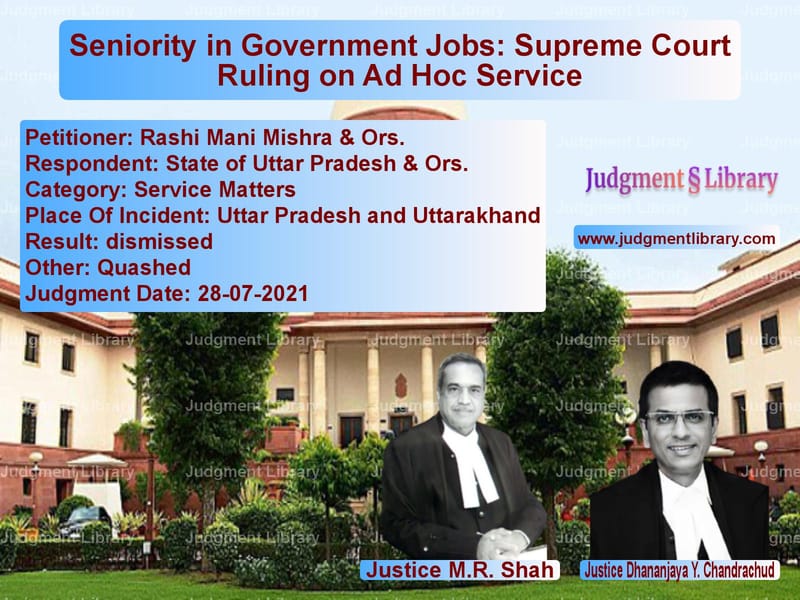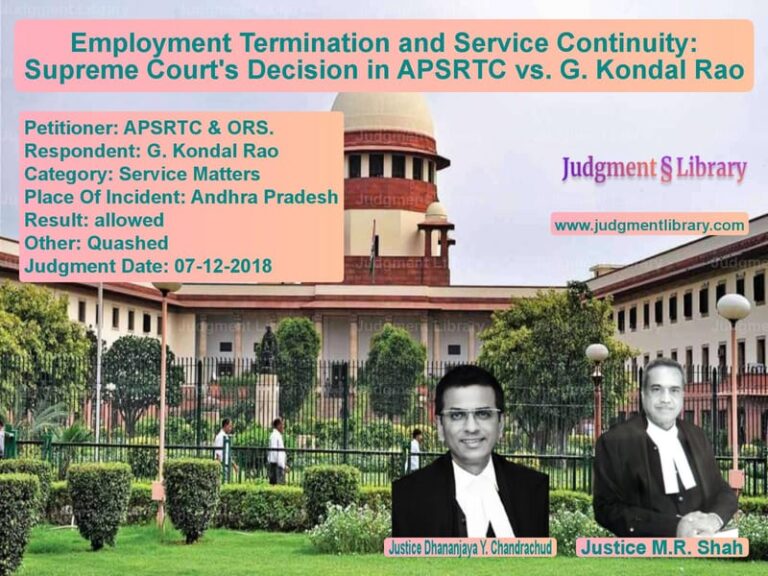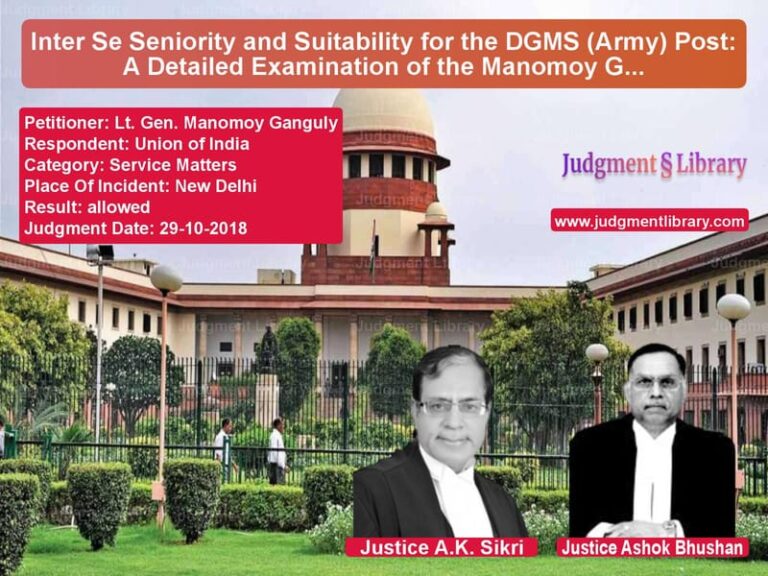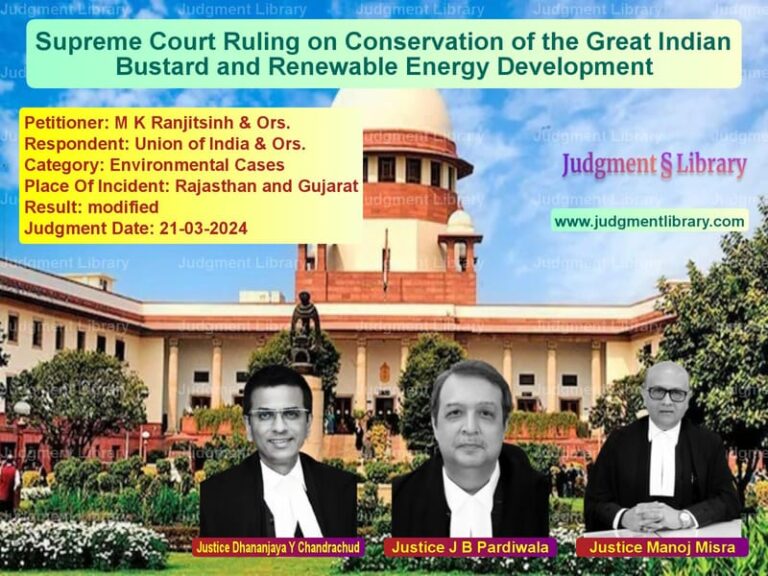Seniority in Government Jobs: Supreme Court Ruling on Ad Hoc Service
The Supreme Court’s decision in Rashi Mani Mishra & Ors. vs. State of Uttar Pradesh & Ors. addressed a crucial question of whether the seniority of Assistant Engineers in government service should be counted from the date of their ad hoc appointment or from the date of their regularization. The Court ruled that seniority must be counted only from the date of regularization and not from the initial ad hoc appointment. This judgment has a significant impact on government employees who were initially appointed on an ad hoc basis and later regularized.
The ruling clarifies that ad hoc appointments, which are temporary and outside the regular selection process, cannot be equated with substantive appointments for the purpose of seniority. The Court further held that granting seniority from the date of ad hoc appointment would violate the rights of directly recruited employees and create unfair advantages.
Background of the Case
The case involved a dispute over the determination of seniority of Assistant Engineers working in the Rural Engineering Department of Uttar Pradesh and Uttarakhand. The primary question before the Court was:
- Should the services rendered as ad hoc before regularization be counted for seniority?
The dispute originated when 108 Assistant Engineers were given ad hoc appointments in 1985. Their services were subsequently regularized on December 14, 1989, under the provisions of the Uttar Pradesh Regularization of Ad hoc Appointments Rules, 1989. However, a seniority list prepared in 2001 placed these engineers below direct recruits, counting seniority only from the date of regularization. This prompted a challenge from some engineers who argued that their seniority should be counted from the date of their initial ad hoc appointment.
Petitioners’ Arguments
The petitioners, who were initially appointed on an ad hoc basis, contended that:
- Their ad hoc appointments were made through a selection committee, and thus, their service should be counted from the date of initial appointment.
- The Allahabad High Court had ruled in their favor, holding that seniority should be counted from the date of ad hoc appointment.
- The case of Narendra Kumar Tripathi (2015) 11 SCC 80, where the Supreme Court allowed ad hoc service to be counted for seniority, was applicable.
- The re-determination of seniority in 2016, which downgraded their position, was unfair and should be set aside.
Respondents’ Arguments
The State of Uttar Pradesh and other respondents argued that:
- Ad hoc appointments were temporary and did not confer any legal right to seniority.
- The 1979 and 1989 Regularization Rules clearly stated that seniority should be counted from the date of regularization.
- Several Supreme Court rulings, including Santosh Kumar vs. G.R. Chawla (2003), had established that seniority cannot be claimed from the date of ad hoc appointment.
- Allowing ad hoc service to be counted for seniority would disadvantage direct recruits who were selected through a competitive process.
Supreme Court’s Observations and Judgment
Seniority Must Be Counted From Date of Regularization
The Supreme Court rejected the petitioners’ claim and held that seniority can only be counted from the date of regularization. The Court stated:
“A person appointed under these rules shall be entitled to seniority only from the date of order of appointment after selection in accordance with these rules.”
The Court ruled that the principles established in the case of Narendra Kumar Tripathi were per incuriam (decided without considering relevant precedents) and should not be followed.
Impact on Direct Recruits
The Court emphasized that direct recruits, who go through a rigorous selection process, should not be placed below ad hoc appointees. It observed:
“Seniority of ad hoc appointees is to be reckoned from the date of their substantive appointments, not from their temporary or ad hoc service.”
Validity of 2001 Seniority List
The Supreme Court upheld the seniority list of 2001, which placed ad hoc appointees below direct recruits and counted their seniority from 1989, the date of regularization. The re-determined seniority list of 2016, which granted seniority from 1985, was quashed.
Legal Precedents Considered
The Court relied on several key judgments:
- Santosh Kumar & Ors. vs. G.R. Chawla (2003) – Held that ad hoc service cannot be counted for seniority.
- State of Uttarakhand vs. Archana Shukla (2011) – Ruled that services rendered as ad hoc should not be considered for seniority.
- Direct Recruit Class II Engineering Officers’ Association vs. State of Maharashtra (1990) – Established that seniority starts from substantive appointment.
Key Takeaways from the Judgment
- Ad hoc service does not count for seniority – Only regularized service is considered.
- Direct recruits should not be disadvantaged – Giving preference to ad hoc employees over direct recruits is unfair.
- Judicial precedent matters – The Court overruled past judgments that did not consider relevant case law.
- Seniority lists must comply with rules – The Court upheld the 2001 seniority list and quashed the 2016 revision.
Conclusion
The Supreme Court’s ruling in Rashi Mani Mishra vs. State of Uttar Pradesh sets a crucial precedent in service matters. It reinforces that ad hoc service cannot be used to claim seniority over direct recruits, ensuring fairness in government appointments. The judgment upholds the principle that only those who secure permanent employment through proper selection processes should benefit from seniority rules.
This ruling will serve as a reference point for future disputes over seniority in government service, providing clarity on how service tenure should be counted.
Petitioner Name: Rashi Mani Mishra & Ors..Respondent Name: State of Uttar Pradesh & Ors..Judgment By: Justice M.R. Shah, Justice Dhananjaya Y. Chandrachud.Place Of Incident: Uttar Pradesh and Uttarakhand.Judgment Date: 28-07-2021.
Don’t miss out on the full details! Download the complete judgment in PDF format below and gain valuable insights instantly!
Download Judgment: rashi-mani-mishra-&-vs-state-of-uttar-prade-supreme-court-of-india-judgment-dated-28-07-2021.pdf
Directly Download Judgment: Directly download this Judgment
See all petitions in Employment Disputes
See all petitions in Public Sector Employees
See all petitions in Recruitment Policies
See all petitions in Promotion Cases
See all petitions in Disciplinary Proceedings
See all petitions in Judgment by Mukeshkumar Rasikbhai Shah
See all petitions in Judgment by Dhananjaya Y Chandrachud
See all petitions in dismissed
See all petitions in Quashed
See all petitions in supreme court of India judgments July 2021
See all petitions in 2021 judgments
See all posts in Service Matters Category
See all allowed petitions in Service Matters Category
See all Dismissed petitions in Service Matters Category
See all partially allowed petitions in Service Matters Category







